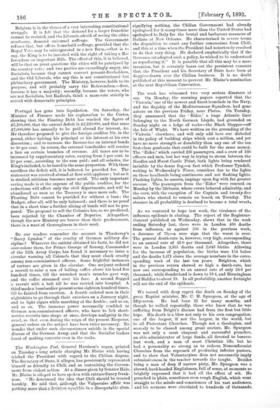The week has witnessed two very serious disasters at sea.
On Monday, the morning papers reported that the Victoria,' one of the newest and finest ironclads in the Navy, and the flagship of the Mediterranean Squadron, had gone ashore on the previous Friday, near Platea. On Tuesday, they announced that the Eider,' a huge Atlantic liner belonging to the North German Lloyds, had grounded on Sunday night on a ledge of rocks—the Black Slopper—off the Isle of Wight. We have written on the grounding of the Victoria' elsewhere, and will only add here our disbelief in the policy of building ships which cost a million, and yet have no more strength or durability than any one of the ten first-class gunboats that could be built for the same money. The Eider,' which carried 226 passengers, and a crew of 166• officers and men, lost her way in trying to steam between the Needles and Hurst Castle Point, both lights being rendered invisible by the dense fog,—a fact which Professor Tyndall, writing to Wednesday's Times, considers due to the lights on those headlands being continuous and not flashing lights_ Flashing lights, he asserts, impinge upon fog with far greater success. The passengers from the Eider' were rescued on Monday by the lifeboats, whose crews behaved admirably, and the crew, with the exception of the Captain and twenty-five sailors who elected to• remain on board, on Tuesday. The steamer in all probability is destined to become a total wreck,






































 Previous page
Previous page